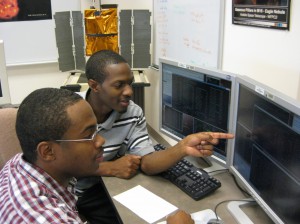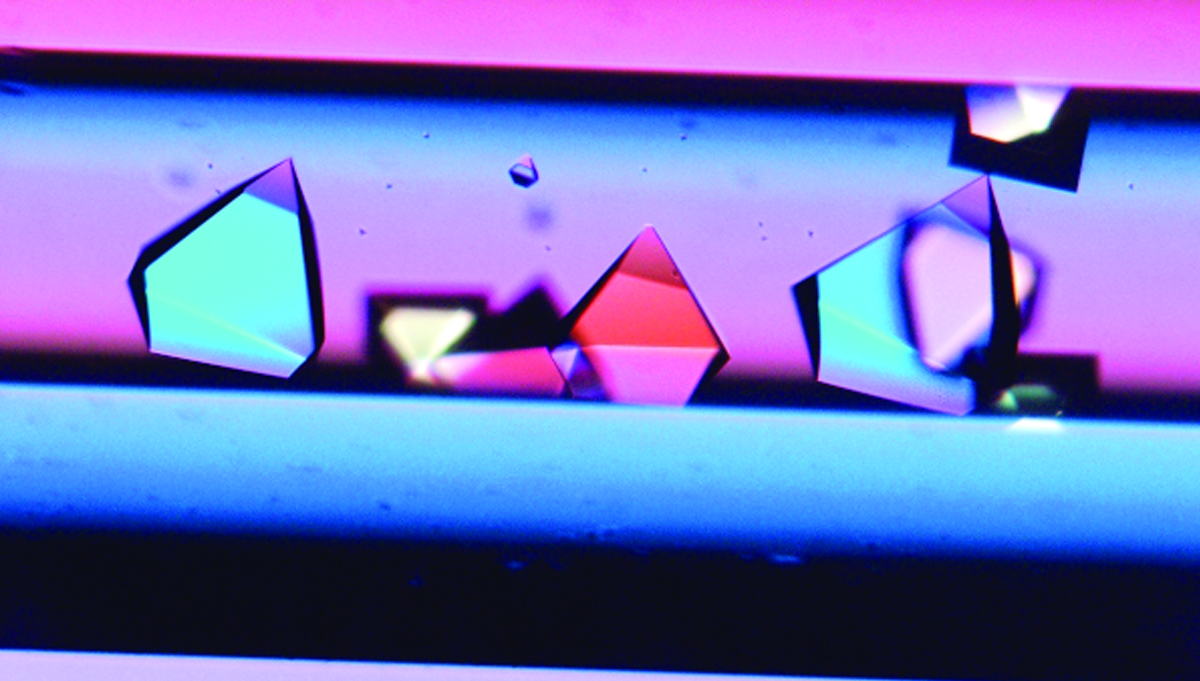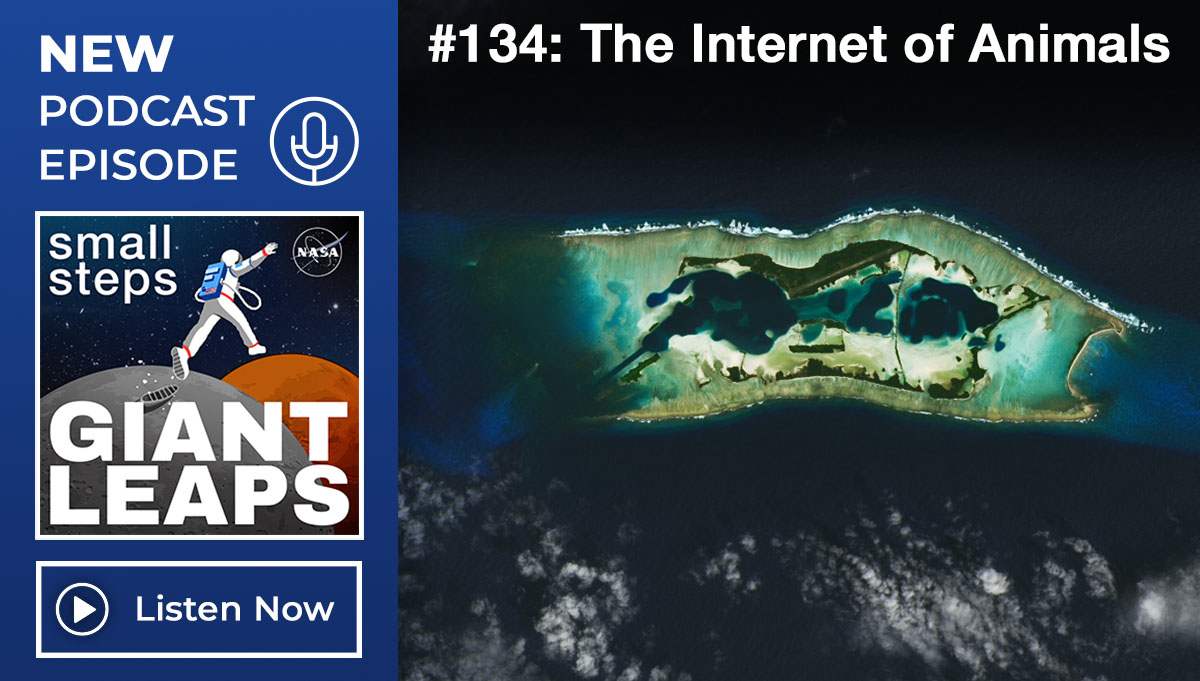
By Leigh Gatto and Todd Watson
A yellow caution flag pops up on the monitor with the message, “Battery Voltage to Temperature Ratio Is Out of Limits!” “That’s okay,” mathematics senior and certified spacecraft analyst Darrell Washington tells computer science senior and certified command controller Kevin Gross. “We just changed the V/T ratio on the spacecraft this morning, so we expect to see that flag.” It is just another day on campus and another real-time contact with an orbiting NASA satellite.
Located on the campus of Bowie State University in suburban Washington, D.C., the Bowie Satellite Operations and Control Center (BSOCC) has been training students in real-time satellite flight operations since 1996. This innovative program combines a rigorous series of mission control certifications with daily flight operations for NASA’s Solar, Anomalous, and Magnetospheric Particle Explorer (SAMPEX). The SAMPEX spacecraft collects data on solar and galactic radiation and is controlled from the university’s mission operations center. Students take part in almost all aspects of flight operations while pursuing three progressively advanced levels of mission control certification. Along with their work in the BSOCC, they also carry a full-time schedule of college classes in science and technology.
Building the BSOCC
The idea for the BSOCC took shape in the mid-1990s, when former Goddard Space Flight Center Director Joe Rothenberg wanted to reduce the operating costs of extended-duration science missions by using university-based control centers and student participation. Bowie State University, one of the nation’s oldest Historically Black Colleges and Universities, has had a long and productive relationship with Goddard. Just six miles northeast of Goddard, its campus was a logical place to install a mission operations center. NASA’s Leigh Gatto, the Small Explorers mission director at the time, was asked to build the facility and move SAMPEX flight operations to Bowie State University.

Before a solar storm in 2003, Earth’s radiation belts underwent significant changes in structure. This image showing low particle flux was built from SAMPEX measurements.
Image Credit: NASA
When we first began building the facility, we had no money and no place to go,” explained Gatto. “At the time, Dr. Nagi Wakim was the Associate Provost of Bowie State University and a steadfast supporter of the BSOCC concept. Together, Nagi and I lobbied Bowie State and Goddard for resources. We applied for and won seed money from the Goddard Director’s Discretionary Fund. We also convinced the university to section off a corner of the campus’s main library to build the ops center. With initial resources acquired, we met with the SAMPEX principal investigator. Together we were able to convince him that his spacecraft would be well cared for under the watchful eyes of university students.”
Mission oversight and student training are currently performed by Todd Watson, a Honeywell employee who functions as both satellite engineer and center director. Watson was a part of the BSOCC from the very beginning, one of the first group of trainees in 1996. After the company he worked for went out of business, he enrolled in Bowie State’s computer science graduate program and one day happened to see a poster advertising for NASA flight-control candidates. “I was astonished that there was such a program on campus and went right over to apply,” he said. He completed all the certifications, was hired by Honeywell, and eventually took on leadership of student training and flight operations.
The BSOCC concept calls for the university to provide the facility and the student stipends, while NASA provides the spacecraft, control center equipment, and one full-time flight operations professional. The BSOCC’s certification program is based on the training used by the Small Explorers program at Goddard and was developed by Honeywell.
BSOCC Missions and Technology
SAMPEX was launched into low-Earth orbit in 1992. The spacecraft has four scientific sensors designed to study solar energetic particles, anomalous cosmic rays, galactic cosmic rays, and magnetospheric physics. Mission data is delivered to scientists at the Aerospace Corporation in El Segundo, California.
The Wide-field Infrared Explorer (WIRE) performed a four-year experiment in asteroseismology (a science concerned with the structure of variable stars) while being controlled from the BSOCC. That experiment was concluded in 2008.

Bowie State University students Darrell Washington and Kevin Gross at the controls during a NASA satellite contact.
Photo Credit: Todd Watson
Along with being the primary control center for these missions, BSOCC has served as a backup control center for NASA’s Submillimeter Wave Astronomy Satellite and its Transition Region and Coronal Explorer (TRACE). BSOCC recently hosted TRACE operations for two weeks while satellite operations were moved into a new facility at Goddard.
In BSOCC, students also take part in the mission support work that goes along with flying satellites. The Bowie State facility has undertaken several ground-system upgrades, helped test and implement Goddard Mission Services Evolution Center technology, and performed numerous ground-station proficiency and engineering tests. Approximately forty students have been certified in the program, and nearly ninety flight control certifications have been awarded. About half these graduates now work in the aerospace industry, most of them with NASA and its contractors. BSOCC students have a 100 percent college graduation rate.
In 2003, the BSOCC moved from its original location in the campus’s main library to a much larger facility in Bowie State’s new computer science building. The program added flight operations for a second mission, the WIRE spacecraft, which performed stellar seismology observations until the spring of 2008. SAMPEX, staying remarkably healthy over its long lifetime, has remained BSOCC’s primary mission. It continues to provide valuable data to the scientific community while ensuring the futures of dozens of students.
BSOCC’s Training Program
Since the beginning of the program, training has centered on mission controller certification. It takes two years, including one summer, to complete the three levels of command controller, mission planner, and spacecraft analyst. The command controller learns how to set up and take real-time satellite contacts while monitoring the receipt of data from the NASA tracking stations. During a contact, the command controller sends commands to the spacecraft and ensures that telemetry—comprising attitude control, engineering, and science data—is properly downlinked to the ground station.
The mission planner learns how to build the “command loads” that are uplinked to the spacecraft during real-time contacts. Command loads contain instructions for the satellite to follow when it isn’t in contact with controllers on the ground—such as turning the transmitter on or off and cycling power for the scientific sensors. The mission planner also verifies the schedules of contacts with the NASA tracking stations, ensuring that minimum requirements for viewing-period duration and spacecraft elevation are met.
The spacecraft analyst is the final and most advanced level of mission control certification offered in BSOCC. The analyst helps oversee the activities of the command controller and the mission planner and is responsible for identifying spacecraft anomalies and starting the process of resolving them. The analyst must understand the satellite’s subsystems, including power, thermal, attitude control, communications, computer, and payload. He or she should be able to identify any anomalous conditions with either the ground system or the spacecraft.
Training includes classroom sessions, hands-on experience, and independent study. After passing a long list of skill demonstrations, the trainees must pass a written test for each certification. Students work and train in the facility between classes and have adequate opportunities to participate in real-time satellite contacts. The control center normally teems with activity; in addition to operating satellites, the students take part in mission-support tasks such as data trending and spacecraft anomaly investigation.
Occasionally a fully certified student will still have time to work in BSOCC before graduation. Along with acting as peer mentors to the newer interns, these advanced students may be assigned special projects involving satellite subsystem research or creating and editing computer scripts and programs.
The Present and the Future
One student, Alicia Scott, worked in the BSOCC while earning her master’s degree in computer science. Since graduation, she has worked at Goddard for NASA contractors Honeywell and SAIC, where she has participated in mission support for the Terra, Tropical Rainfall Measuring, and Hubble missions. Scott said, “I was able to apply everything I learned in the BSOCC to the daily operation of the Terra mission at Goddard. It was a great relief to the management team that I was already knowledgeable of the basics involved in mission operations. The most critical thing I took from the BSOCC was the importance of communication between members of the operational team. The most effective procedures and commands for spacecraft ops result from good communication. The three levels of certification at the BSOCC allowed me to view operations from different standpoints and to focus on one aspect at a time. Once I started my job with the Terra mission, it was easy to combine all these standpoints into one position. I was performing all duties learned at BSOCC and was better able to focus on anomaly recovery and error prevention, which is essential to the life of a mission.”

SAMPEX’s Proton-Electron Telescope instrument captured these energetic electron fluxes over the North Pole between July 1992 and July 1993.
Image Credit: NASA
Miquel Moe completed the BSOCC certifications as an undergraduate in math and engineering. He is now an electronics engineer for NASA at Goddard, where he leads the screening of electrical components for the design phase of the ICEsat-2 mission. Moe believes the BSOCC training helped put his career on track. “First and foremost, BSOCC provided me a quality, real-life work experience while allowing me to focus primarily on my undergraduate studies,” he explained.
“The skills I acquired working for BSOCC have made me very attractive to employers such as the National Oceanic and Atmospheric Administration and NASA Goddard, for whom I now work. Not only do I understand the engineering aspect of space missions, I also understand the scientific, data acquisition, and spacecraft-commanding aspects. This knowledge paid me great dividends in the past as an intern working on the Geostationary Operational Environmental Satellite project, and it will continue to pay off in my future as an employee.”
With its fully equipped mission control center, the BSOCC is well positioned to take on new projects for NASA. As more students take advantage of this unique training, the pool of talent available to the local aerospace community will increase. Current BSOCC student and mathematics major Darrell Washington put it this way: “With BSOCC on my résumé I know that there’s someone out there who will take an interest.”
About the Author










